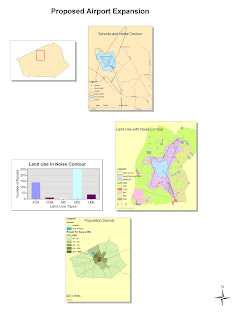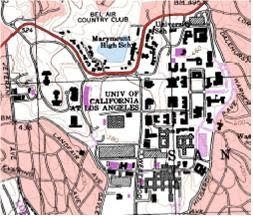










1. What is the name of the quadrangle? Beverly Hills Quadrangle California 7.5-Minute Series (Topographic)
2. What are the names of the adjacent quadrangles? Canoga Park, Van Nuys, Burbank, Topanga, Hollywood, Venice, Inglewood
3. When was the quadrangle first created? 1966
4. What datum was used to create your map? Metadata
5. What is the scale of the map? 1:24,000
6. At the above scale, answer the following:
a) 5 centimeters on the map is equivalent to how many meters on the ground? 1200
b) 5 inches on the map is equivalent to how many miles on the ground? 1.89 miles
c) one mile on the ground is equivalent to how many inches on the map? .0000416
d) three kilometers on the ground is equivalent to how many centimeters on the map? 12.5
7. What is the contour interval on your map?
20 ft
8. What are the approximate geographic coordinates in both degrees/minutes/seconds and
decimal degrees of:
a) the Public Affairs Building? Lat: 34.07422 Long: -118.44016 Lat: 34,4’,27.2”
Long: -118,26’,24.6”
b) the tip of Santa Monica pier? Lat: 34.00768 Long: -118.49967 Lat: 34,0’,27.7”
Long: -118,29’,58.8”
c) the Upper Franklin Canyon Reservoir? Lat: 34.12099 Long: -118.49967 Lat: 34,7’,15.6”
Long: -118,27’,19.6”
9. What is the approximate elevation in both feet and meters of:
a) Greystone Mansion (in Greystone Park)? 600ft 182.88 m
b) Woodlawn Cemetery? 140ft 42.672 m
c) Crestwood Hills Park? 700ft 213.35 m
10. What is the UTM zone of the map? 11
11. What are the UTM coordinates for the lower left corner of your map?34,1’,18”
12. How many square meters are contained within each cell (square) of the UTM gridlines? 1,000m2
13. Obtain elevation measurements, from west to east along the UTM northing 3771000,
where the eastings of the UTM grid intersect the northing. Create an elevation profile
using these measurements in Excel (hint: create a line chart). Figure out how to label
the elevation values to the two measurements on campus. Insert your elevation profile
as a graphic in your blog.
14. What is the magnetic declination of the map? 13,12’
15. In which direction does water flow in the intermittent stream between the 405 freeway
and Stone Canyon Reservoir? From North to South
16. Crop out (i.e., cut and paste) UCLA from the map and include it as a graphic on your
blog.
